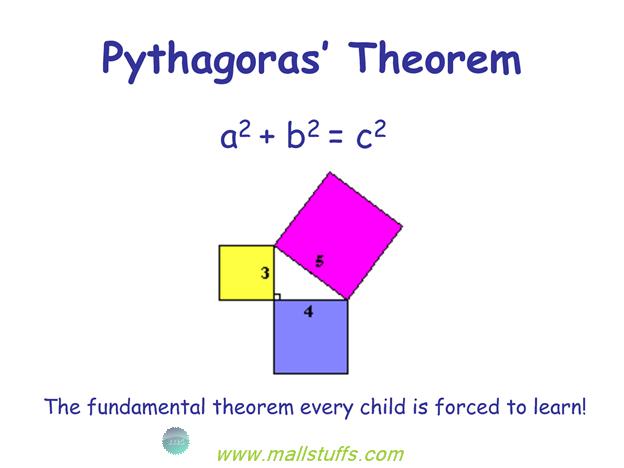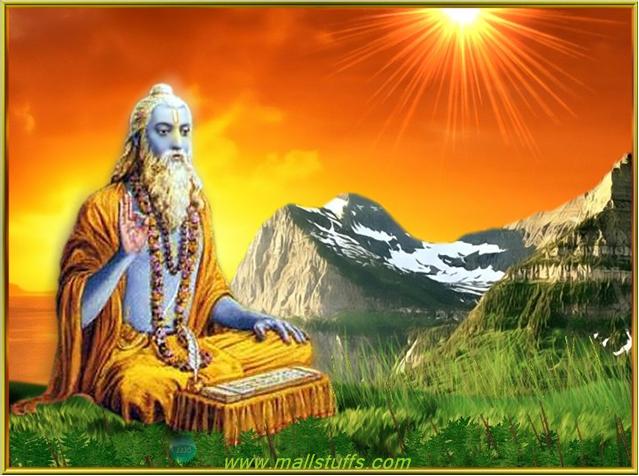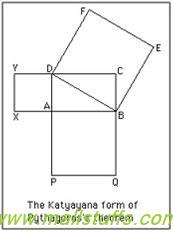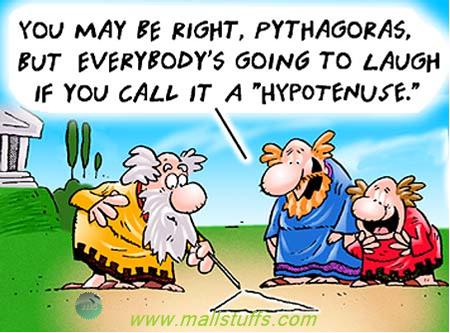
Science in Hinduism-Pythagoras or Baudhayana theorem
Introduction:
In schooling, geometry starts with Pythagoras theorem. So, obviously all the literates out there must have learnt about Pythagoras theorem. Almost everyone in this world irrespective of whether they are scientists, engineers, doctors etc has applied Pythagoras theorem in different walks of their life. Though you know the implication and uses of Pythagoras theorem, you may not know that Pythagoras theorem is not his original theorem and is copied from Indian scriptures. The reason I am saying this is because he never proved his theorem. One of the reasons why he was not able to prove his theorem was because of the faulty number system (without 0) that existed in the west in those times. Procedure of carrying the remainder of one column over to the next, dividing fractions, use of equations and letters were unknown to western world in those times. Hence, it was impossible for Pythagoras to prove his theorem.
Check the below video for detailed graphical explanation of this article
Science in Hinduism-Large numbers and infinity
Science in Hinduism-Invention of numeral system
Now, the very fact that he was not able to prove his theorem proves that he didn’t discover this theorem. The obvious question arises, “If he didn’t discover this theorem then who the creator of this theorem is?” Well, the answer is Baudhayana.
What is Pythagoras theorem?
Before I tell you about Baudhayana, let’s have a recap on Pythagoras and his so called Pythagoras theorem.
Pythagoras was the Greek mathematician, said to be influenced by Greek prince ‘Seleucus’, shortly after the Greek emperor ‘Alexander the Great’ arranged his daughter marriage with an Indian king and sent an ambassador, Megasthenes, to the court of Chandragupta Maurya (grandfather of king Ashoka the great).
Pythagoras Theorem states that
“In right angle triangle, the area of the square whose side is hypotenuse is equal to the sum of the areas of the squares whose sides are the two legs”.
Equation of this statement was later devised as “a�+b�=c�”.

Proof of this important theorem was not given by Pythagoras but was well known from Euclid's time until the present, yet the Vedas reveals five extremely simple but different proofs for this theorem. Proof of this theorem is found not only in Sulba Sutra (800 BC), but also in the earlier text like Shatapatha Brahmana(900 BC).
Pythagoras and his theories based on Indian philosophy
If you read out the theories of Pythagoras, you will find that his theories deeply reflect the Sankhyan philosophy which kind of depicts his familiarity with Upanishads (ancient Indian religious text). Some of the other theories of Pythagoras that matches with Indian philosophy are:
1) He believed in transmigration of souls, a concept alien to western world

Transmigration of soul as mentioned in bhagavad gita
2) Five elements constitutes matter (Earth, ether, fire, water, air)
3) Reasons for not eating plants products grown underground (Jain belief)
4) Religious and philosophy closely resembling Buddhism
5) His Contents on mystical speculations striking similar to ones written in Upanishads.
It is said that during his visit to India, he gathered various Indian philosophy and Vedic knowledge and projected those in the west out of which his “hypotenuse” theorem is today known all over the world as Pythagoras theorem.
Baudhayana, Real founder of Pythagoras theorem
Real founder of Pythagoras theorem is Baudhayana. Baudhayana(800 BC) is an ancient Indian mathematician cum sage, who gave the geometrical proof of the Pythagoras theorem for an isosceles right angled triangle. He is the author of Sulbha Sutra, Dharma Sutra and Shrauta Sutra. Baudhayana is also known for calculating the value of pi up to some degrees of precision. “Sulbha Sutra” written by Baudhayana centuries before the Pythagoras was even born has the earliest account of Pythagoras theorem. He not only proved Pythagoras theorem but also gave the series of algebraic triplets commonly known as Pythagoras triplets.

Baudhayana, Mathematician cum sage
Sanskrit verse from Sulbha Sutra:
“dirghasyaksanaya rajjuh parsvamani, tiryadam mani,
Cha yatprthagbhuta Kurutastadubhayan karoti “.
Translation:
A Rope stretched along the length of the diagonal (hypotenuse) produces an area which the vertical and horizontal sides make together.

Baudhayana is also credited to derive the approximate value of the square root of two, circling of the square (Finding a circle with same that of the square), transform rectangle into square of same area, merge two equal or unequal square to create a third square, Area of rectilinear shapes (are of one shape as sum or difference of two or more other shapes). Beside this, Baudhayana also made several other important discoveries, most of which is used in advanced mathematics.
Why Baudhayana created this theorem
Doing yagna is a very important ritual in Hinduism since time immemorial. To do yagna, we need to construct a rectangular altar on which the woods would be burn to invoke god by chanting mantras.

Priest chanting mantras in front of a circular altar
This rectangular altar must be of a special length and breadth and should be mandatorily square or rectangle (two triangles joint at their hypotenuse). To construct an exact altar, Baudhayana devised his hypotenuse theorem and proved it by measuring the altar with ropes of predefined width and length. Yajur Veda enumerates the various possible shapes of altar and Baudhayana and Apastamba furnished us with details on the types and methodology to be used in the construction of these altars.
The reason why buddhayana was able to prove his theorem while Pythagoras was not is because of the decimal based place value system. Western number system was incomplete without zero while Indian decimal based place value system was complete with sunya(Zero) or void.
Famous historians and authors on Baudhayana theorem
1) "From these famous Indians, it seems most probable that Pythagoras learned, and transported into Greece and Italy, the greatest part of his natural and moral philosophy, rather than from the Egyptians...Nor does it seem unlikely that the Egyptians themselves might have drawn much of their learning from the Indians..Long before Lycurgus, who likewise traveled to India, brought from thence also the chief principles of his laws." - Sir William Temple, English author, diplomat and statesman. Also read
Are Egyptians ancestors Indian in origin
2)

3) "By examining the evidence in the Shatapatha Brahmana, we now know that Indian geometry predates Greek geometry by centuries. For example, the earth was represented by a circular altar and the heavens were represented by a square altar and the ritual consisted of converting the circle into a square of an identical area. There we see the beginnings of geometry! Two aspects of the 'Pythagoras' theorem are described in the Vedic literature. One aspect is purely algebraic that presents number a, b, c for which the sum of the squares of the first two equals the square of the third. The second is the geometric, according to which the sum of the areas of two square areas of different size is equal to another square. The Shatapatha Brahmana, which proceeds the age of Pythagoras, knows both aspects. Therefore, the Indians could not have learnt it from the Old-Babylonians or the Greeks, who claim to have rediscovered the result only with Pythagoras. India is thus the cradle of the knowledge of geometry and mathematics."- Abraham Seidenberg, Author of “The origin of mathematics”
4) "Two thousand years before Pythagoras, philosophers in northern India had understood that gravitation held the solar system together, and that therefore the sun, the most massive object, had to be at its center."- Dick Teresi, historian and author on science and technology
Science in Hinduism-Gravitational force and repulsive force
5) “Sulbasutras (The Rules of the Cord) contain their own version of the Pythagorean theorem as well as procedure for obtaining the square root of 2 correct to five decimal places. The Sulbasutras reveal a rich geometric knowledge that preceded the Greeks."- George Cheverghese Joseph - author
6) "We are told by the Greek writers that the Indians were the wisest of nations, and in moral wisdom, they were certainly eminent."- Sir William Jones, Supreme Court judge, historian and a firm believer in Vedas.
Did Greeks worshipped lord krishna
7) "Plato is full of Sankhyan thought, worked out by him, but taken from Pythagoras. Before the sixth century B.C. all the religious-philosophical idea of Pythagoras are current in India (L. Schroeder, Pythagoras). If there were but one or two of these cases, they might be set aside as accidental coincidences, but such coincidences are too numerous to be the result of change. "- Edward Washburn Hopkins, Professor and historian in Sanskrit studies

8) "It is more likely that Pythagoras was influenced by India than by Egypt. Almost all the theories, religions, philosophical and mathematical taught by the Pythagoreans, were known in India in the sixth century B.C., and the Pythagoreans, like the Jains and the Buddhists, refrained from the destruction of life and eating meat and regarded certain vegetables such as beans as taboo"- Professor H. G. Rawlinson
9) "As regards Pythagoras, it seems to me very probable that he became acquainted with Indian doctrines in Persia."- Professor Maurice Winternitz
10) “Pythagoras had been influenced by the Samkhya school of thought, the most prominent branch of the Indic philosophy next to Vedanta.”- Ludwig von Schröder, German philosopher
11) Pythagoras went to the Ganges to learn geometry- Voltaire
12) India was visited by Pythagoras, Anaxardes, Pyrrho, and others, who afterwards became eminent philosophers in Greece.There are authorities who suggest that Plato had found his way to the bank of the Ganges- Enfield

Ancient trade route though which the Greeks and Egyptians came to India
13) "A greater degree of similarity exists between the Indian doctrine and that of the earlier than the late Greeks. Greek philosophy, especially between Pythagoras and Plato, was indebted to Indian thought”- H. T. Colebrooke, the great Orientalist
14) “Future research on the history of science and technology in Asia will in fact reveal that the achievements of these peoples contribute far more in all pre-Renaissance periods to the development of world science than has yet been realized."- Needham, scholar of Western political thought
Conclusion:
Even though the west is aware of the actual creator of Pythagoras theorem, for some selfish reasons, they are still reluctant to call it Baudhayana theorem. It’s a sad irony for India that in spite of being the cradle of human civilization, we are not given the credit for our discovery and inventions. We have lost our respect because of the invaders, our own corrupt political leaders and the common people who are attracted to western based philosophy full of materialistic desires. The reason why we are heading toward destruction is because “all the inventions of the ancient world were dedicated to god (With the intention of no materialistic desires) while the entire modern world discoveries are dedicated to humans, only for becoming more and more attached to materialistic pleasures.”
Note: Images used on this website
are either a production of Bhaktivedanta Book Trust(https://www.krishna.com), Iskcon
Foundation or were found in google search under "Free to use and share". If any
of the images presented here violates copyright issues or infringes anyone copyright
or are not under "Fair use", then please bring it to our notice. Read
Disclaimer for more.
Share this to your friends. One of your friend is
waiting for your share.
Related Articles
Why lord Krishna is shown with a flute in his hand
Meaning of word Bihar and why bihari is proud of their culture and origin
Why lord Ganesha have elephant head
That is the way i like you
Visit to isckon temple
Science in hinduism-Embryology in Garbhopanishad and Charaka samhita
Bhagavad gita quote against caste system
Science in Hinduism-Big bang,Creation & destruction of universe
Did Greeks worshipped lord krishna
Should software professionals practice spirituality
Post Comment